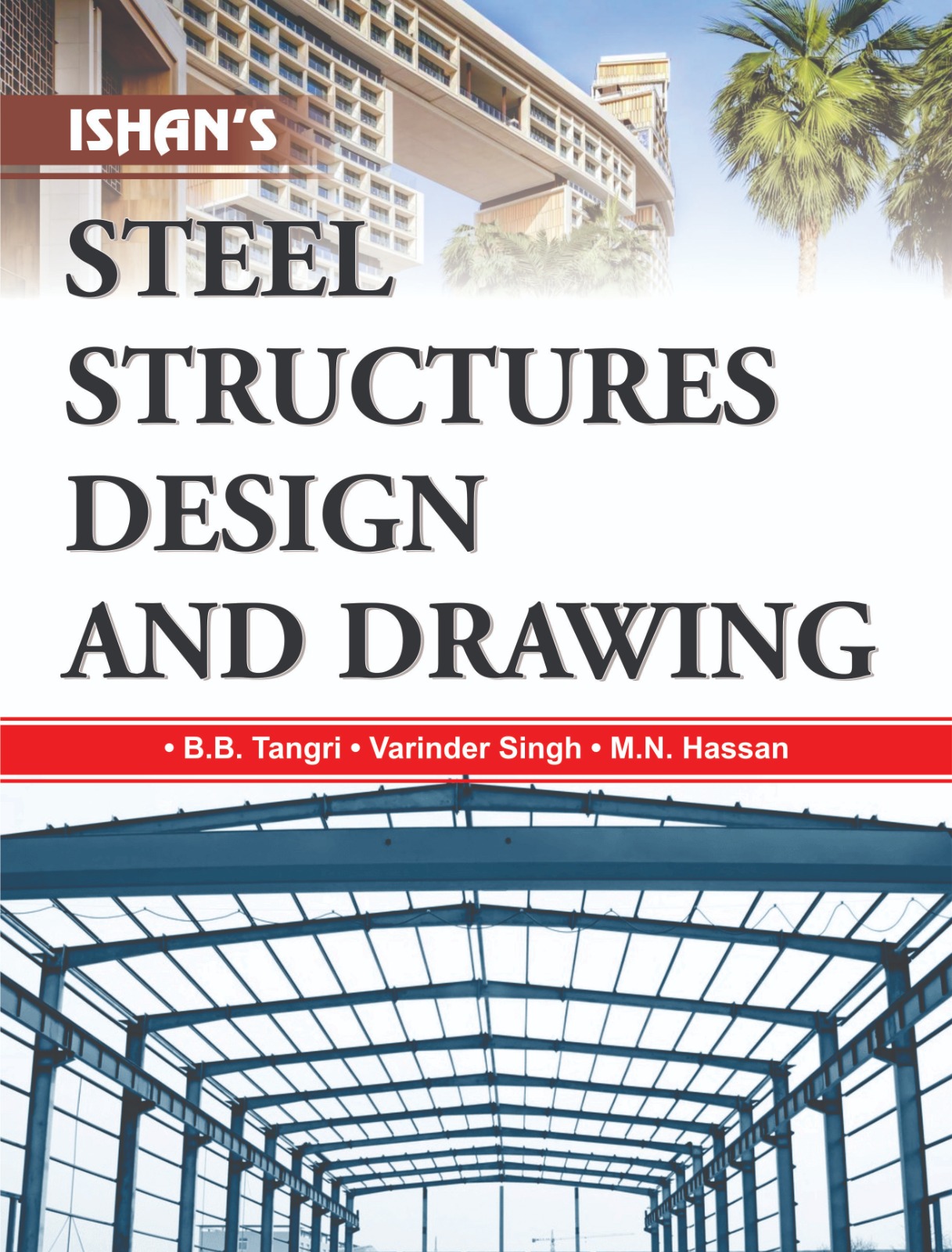By: B.B. Tangri, Varinder Singh, M.N. Hassan
1. STRUCTURAL STEEL SECTIONS .................................................................................................... 1– 16
1.1 Introduction
1.2 Structural Steel and Sections
1.2.1 Advantages of Steel as Structural Material
1.3 Mechanical Properties of Steel
1.4 Structural Steel
1.5 Standard Steel Sections
1.6 Concept of Determinate & Indeterminate Structures
Exercise
2. STRUCTURAL STEEL CONNECTIONS (RIVETED CONNECTION) ............................................... 17–61
2.1 Introduction
2.1.1 Important Riveted Connections for Different Structural Members
2.2 Rivet
2.3 Types of Rivets
2.4 Rivet Size
2.5 Riveting & Process
2.6 Important Terms used in Riveting
2.7 Specifications for Riveted Connections
2.8 Types of Riveted Joints
2.8.1 Lap Joints
2.8.2 Butt Joints
2.9 Failure of Riveted Joint
2.10 Design of Riveted Joints
2.11 Strength of Riveted Joint
2.12 Rivet Value (R)
2.13 Efficiency of Joint
2.14 Number of Rivets
2.15 Arrangement of Rivets
2.16 Determination of Strength of Joint and Efficiency
2.17 Design of Rivets Connection
Exercise
3. BOLTED AND WELDED CONNECTIONS ..................................................................................... 62–99
3.1 Introduction
3.1.1 Advantages of Bolted Connections
3.1.2 Disadvantages
3.1.3 Types of Bolt
3.1.4 Types of Bolted Connections
3.1.5 Specifications for Bolted Joints As Per IS:800 – 2007
3.1.6 Bearing Type Connection
3.1.7 Efficiency of Bolted Joint
3.2 Introduction to Welded Joints
3.3 Welded Connections
3.4 Welding
3.5 Welding Process
3.6 Advantages and Disadvantages of Welding
3.7 Types of Welds
3.8 Strength of Butt Weld
3.9 Strength of Fillet Weld
3.10 Design of Welded Joints
3.11 Design of Welded Joint for Unsymmetrical Sections with Axial Loads
3.12 Inspection of Welds
Exercise
4. TENSION MEMBERS ................................................................................................................. 100–134
4.1 Introduction
4.2 Tension Members
4.3 Types of Sections
4.4 Permissible Stresses
4.5 Strength
4.6 Permissible Stress
4.7 Net. Area (For Plates)
4.7.1 Net Area (For Angles and T-Sections)
4.8 Design of Tension Members
Exercise
5. COLUMNS COMPRESSION MEMBERS .................................................................................... 135–168
5.1 Introduction
5.2 Classification of Columns
5.3 Types of Sections
5.4 Definitions of Important Terms
5.5 Strength of Column
5.6 Tacking Rivets IS-800-2007
5.7 Design of Columns
5.7 (A) Splices for Columns
5.8 Column Bases
5.9 Beams & Column, Frame & Fitted Connections
6. STRUTS ...................................................................................................................................... 169–190
6.1 Angle Struts (Compression Memners)
6.1.1 Discontinuous Strut
6.1.2 Continuous Angle Struts
6.2 Design Procedure
6.3 Lacing and Battening of Compound Columns
Exercise
7. BEAMS ....................................................................................................................................... 191–225
7.1 Introduction
7.2 Theory of Simple Bending
7.3 Bending Equation
7.4 Permissible Stress
7.5 Deflection Limit
7.6 Self Weight of Beam
7.7 Laterally Restrained Beams
7.8 Design of Laterally Supported (Restrained Beam)
7.9 Other Considerations for Design of Beam
7.10 Design of Bearing Plate for Steel Beam
7.11 Built Up Beams
7.12 Plate Girders
7.13 Components of a Plate Girder
7.14 Design Considerations
7.15 Web Stiffeners
7.16 Horizontal Stiffeners
7.17 Curtailment
7.18 Connection of Beam with Beam
Exercise
8. STEEL ROOF TRUSS ................................................................................................................... 226–242
8.1 Introduction
8.2 Steel Frames
8.3 Perfect and Imperfect Frame
8.4 Types of Trusses
8.5 Parts of A Roof Truss
8.6 Types of Load
8.7 Load Combination
8.8 Economical Spacing of Trusses
8.9 Practical Points for Design Fabrication and Fixing of Steel Trusses
8.10 Design Of Angle Iron Purlin for Slope not Exceeding 30 Degrees
8.11 Templates
8.12 Purlins
8.13 End Position
8.14 Roof Coverings
8.15 Fixing of Sheets
Exercise
9. FABRICATION AND ERACTION OF STEEL STRUCTURES ........................................................ 243–246
9.1 Fabrication
9.2 Fabrication Procedure
9.2.1 Surface Cleaning
9.2.2 Cutting and Machining
9.2.3 Punching and Drilling
9.2.4 Straightening, Bending and Rolling
9.2.5 Fitting and Reaming
9.2.6 Fastening Methods
9.2.7 Finishing
9.2.8 Surface Treatment
9.3 Eraction
9.3.1 Sequence of Erection
10. MASONARY STRUCTURES ....................................................................................................... 247–252
10.1 Foundation
10.1.1 Purpose of Foundation
10.1.2 Types of Foundations
10.1.3 Loads on Foundation
10.1.4 Depth of Foundation
10.1.5 Size of Foundation
STEEL STRUCTURES DRAWING
11. STEEL STRUCTURES ................................................................................................................... 253–260
11.1 Steel
11.2 Structural Steel
11.3 Structural Steel Sections
11.3.1 Rolled Steel Angle Sections
11.3.2 Rolled steel I-Sections or Beam Sections
11.3.3 Rolled Steel Channel Sections
11.3.4 Rolled Steel Tee Sections
11.3.5 Rolled Steel Bars
11.4 Structural Steel Connections
11.4.1 Riveted Connections or Riveted Joints
11.4.2 Types of rivets
11.5 Terms Related to Riveted Joints
12. ROOF TRUSS ........................................................................................................................... 261–265
13. COLUMN AND COLUMN BASES.............................................................................................. 266–280
14. COLUMN BEAM CONNECTIONS ............................................................................................. 281–299
15. PLATE GIRDER ........................................................................................................................... 300–303
16. AUTOCAD (STEEL STRUCTURES) .............................................................................................. 304–305
• STEEL TABLES ............................................................................................................................ 306–328

 Rs.325
15.38% off
Rs.325
15.38% off